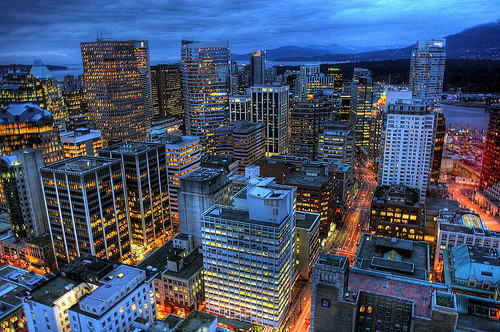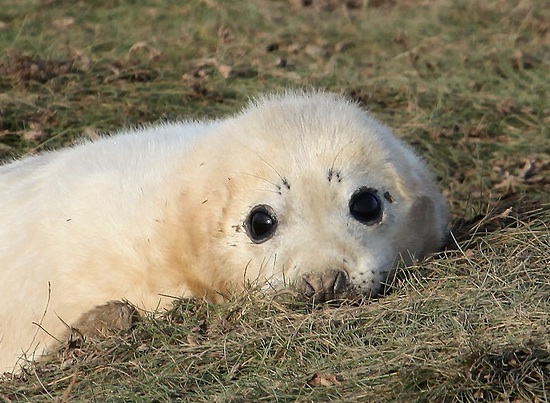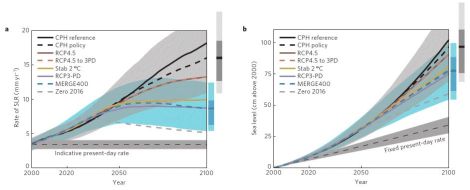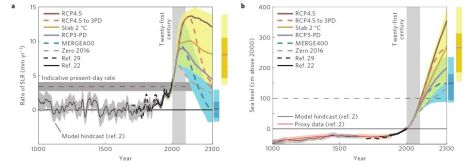
No, don’t be sad, *seal* levels are fine!
The seas will rise! That is one of the easiest climate-change impacts to convey to the lay public and one of the most controversial. Part of why it’s so hotly contested is that it’s easy to visualize sea-levels rising. It’s easy to imagine, to portray in striking visual images. Its power as metaphor, as symbolism, gives it a cultural charge.
But there’s also a more prosaic reason there’s been so much fighting about sea levels. It goes like this: In its most recent report, the Intergovernmental Panel on Climate Change (IPCC) made projections of sea-level rise based solely on the thermal expansion of the oceans. (As water warms, it expands.) That got them up to around a meter (3.3 feet) by 2300, which is not nothing, but not apocalypse either.
What the IPCC didn’t integrate is the effect of land-based ice sheets in, e.g., Greenland and West Antarctica, melting and collapsing into the ocean. At the time, the science around temperature and ice sheets was too tentative and speculative.
Here’s the thing, though: they really are melting, whether or not they’re plugged into the spreadsheet. All the dangerous scenarios around sea levels are based on those melting ice sheets. It’s a potentially far larger effect that thermal expansion. When Al Gore shows a slide of the seas swamping Manhattan, that’s what he’s talking about. The “official” sea-level numbers, from the IPCC, don’t support those kind of high-end sea-level scenarios, so Gore and many others have long come in for all sorts of sh*t from Very Serious People for exaggerating. For years, some people have tried to raise alarm about sea levels, others have accused them of “alarmism,” and the public has tuned out.
As it happens, ice sheet research has come a long way since 2005 (the effective cutoff for the 2007 IPCC report) and so more comprehensive projections are possible. A new paper in Nature Climate Change will, I hope, help drag this debate into the scientific present. Lead author Michiel Schaeffer and his colleagues developed a model that combines paleoclimate data — how temperatures and sea levels correlated in past centuries — with more recent satellite data to project sea-level rise for various climate scenarios.
The news is not good. The press release struggles to put a positive spin on things by noting that limiting temperature rise to 1.5 degrees C “could halve sea-level rise by 2300, compared to a 2-degree scenario.” In their mid-probability scenario for 2 degrees, sea levels rise up to 3 meters (9.8 feet) by 2300. The good news is that 1.5 degrees raises seas only 1.5 meters (5 feet) by 2300!
These numbers don’t tell the whole story, though. It will be the rate of sea-level rise, more than sea level itself, that determines how difficult it will be for humans and other species to adapt. So can we slow down or stop the rate of change in sea levels?
It matters a great deal, because small differences in the rate of sea-level rise over the coming century will have huge consequences for total sea-level rise in subsequent centuries. (Once again: the decisions we make in the next few years are very important!) Here’s how it looks from 2000 out to 2100 (that’s rate of rise on the left, total rise on the right):
Now, for context, here’s what it looks like back to 1000 and forward to 2300:
That chart on the lower right ought to make your palms sweat.
So can we ever stop sea levels rising? Er … theoretically. If we limit temperature rise to 1.5 degrees C, Schaeffer et al. project that by 2300 the rate of sea-level rise will decline back to zero — i.e., sea levels will stabilize, albeit more than a meter higher than they are today.
So that’s the good news. The bad news is that if we let temperature rise even 2 degrees C, by 2300 sea level will still be rising at a rate of around 8 millimeters a year, lower than its peak rate but still higher than humans have ever experienced.
The even worse news, as anyone who’s read my brutal logic posts knows, is that limiting temperature rise to 1.5 degrees C is probably flatly impossible at this point, and limiting to 2 degrees C is, while technically and economically possible, probably politically impossible. We’re currently on a trajectory for as much as 6 degrees.
The highest temperature Schaeffer et al. modeled is 4.5 degrees C. Here’s a paragraph to chill the blood:
In the RCP4.5 scenario, SLR [sea-level rise] approaches 2-5 m by 2300 and reaches rates of SLR much higher than observed over the twentieth century, or estimated using satellite-based data over the period 1993-2007. The RCP4.5 to 3PD scenario shows that if mitigation is delayed for many decades, not even a massive mitigation effort (starting in 2100 when SLR is still under 1 m) can prevent sea levels from rising by at least 1.6 m and possibly even 4.2 m by the year 2300, because of the large inertia in the system. [my emphasis]
So, if we f*ck around and allow temperature to rise 4.5 degrees C, by 2300 sea levels could be up to 5 meters (16.4 feet) higher and rising at around 13 mm a year. That will be tons of fun to adapt to for all Earth’s creatures, I’m sure.
The authors freely admit that there remains a great deal of uncertainty about the precise numbers, but as they note, the precise numbers are not the significant lesson here:
A key aspect of this, irrespective of the exact numbers, is the long response time of sea level that is physically expected from the slow response of large ice sheets and the deep ocean to climate change, and also found in palaeoclimate data. This slow response means that about half of the twenty-first century SLR is already committed from past emissions. It further means that mitigation measures, even an abrupt switch to zero emissions, have practically no effect on sea level over the coming 50 years and only a moderate effect on sea level by 2100. However, the scale of mitigation can have a large effect on the rate of rise by 2100 and a major effect on magnitude of SLR in the centuries thereafter. Twenty-first century mitigation can substantially slow down the rate of SLR and ultimately limit the rise, in the absence of nonlinear, dynamical responses from the ice sheets.
So if we bust our asses for the rest our lives, we can protect our post-2100 descendents from the worst of sea-level rise. Whee! And note that clause tucked away at the bottom there. We can do this if ice sheets do not experience “nonlinear, dynamical responses,” i.e., tipping points.
It’s not good news. But it’s not getting any better and whining won’t change it. Nothing to do but keep plugging away.






